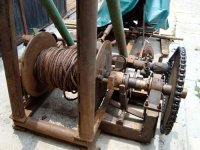From:
Differential (mechanical device) - Wikipedia, the free encyclopedia
..for example, if the car is making a turn to the right, the main crown wheel may make 10 full rotations. During that time, the left wheel will make more rotations because it has further to travel, and the right wheel will make fewer rotations as it has less distance to travel. The sun gears (which drive the axle half-shafts) will rotate in opposite directions relative to the ring gear by, say, 2 full turns each (4 full turns relative to each other), resulting in the left wheel making 12 rotations, and the right wheel making 8 rotations.
The rotation of the crown wheel gear is always the average of the rotations of the side sun gears.
=====================
If the ring gear turns 10 times, and the right wheel turns 0 times, the left wheel must turn 20 times.
Bruce
Differential (mechanical device) - Wikipedia, the free encyclopedia
..for example, if the car is making a turn to the right, the main crown wheel may make 10 full rotations. During that time, the left wheel will make more rotations because it has further to travel, and the right wheel will make fewer rotations as it has less distance to travel. The sun gears (which drive the axle half-shafts) will rotate in opposite directions relative to the ring gear by, say, 2 full turns each (4 full turns relative to each other), resulting in the left wheel making 12 rotations, and the right wheel making 8 rotations.
The rotation of the crown wheel gear is always the average of the rotations of the side sun gears.
=====================
If the ring gear turns 10 times, and the right wheel turns 0 times, the left wheel must turn 20 times.
Bruce

